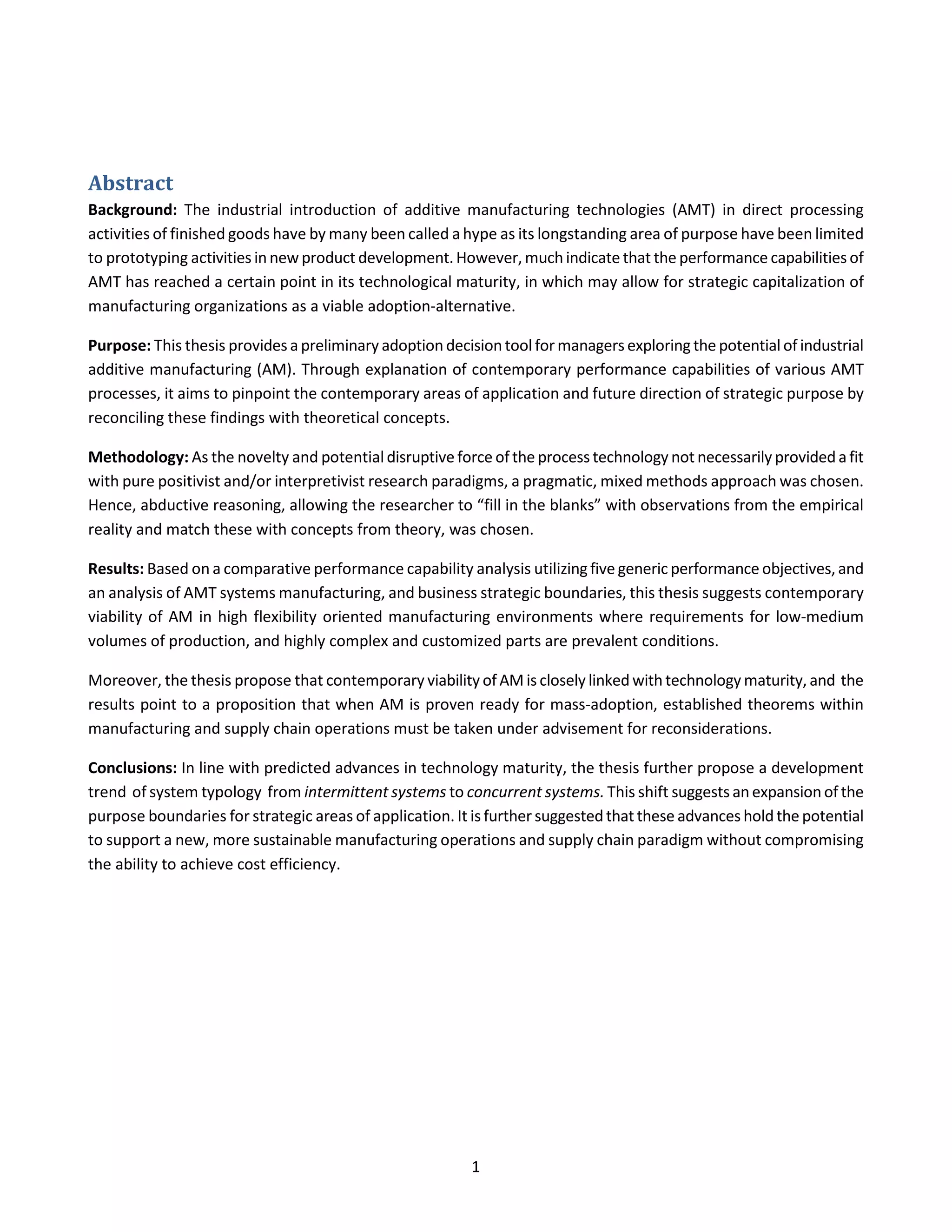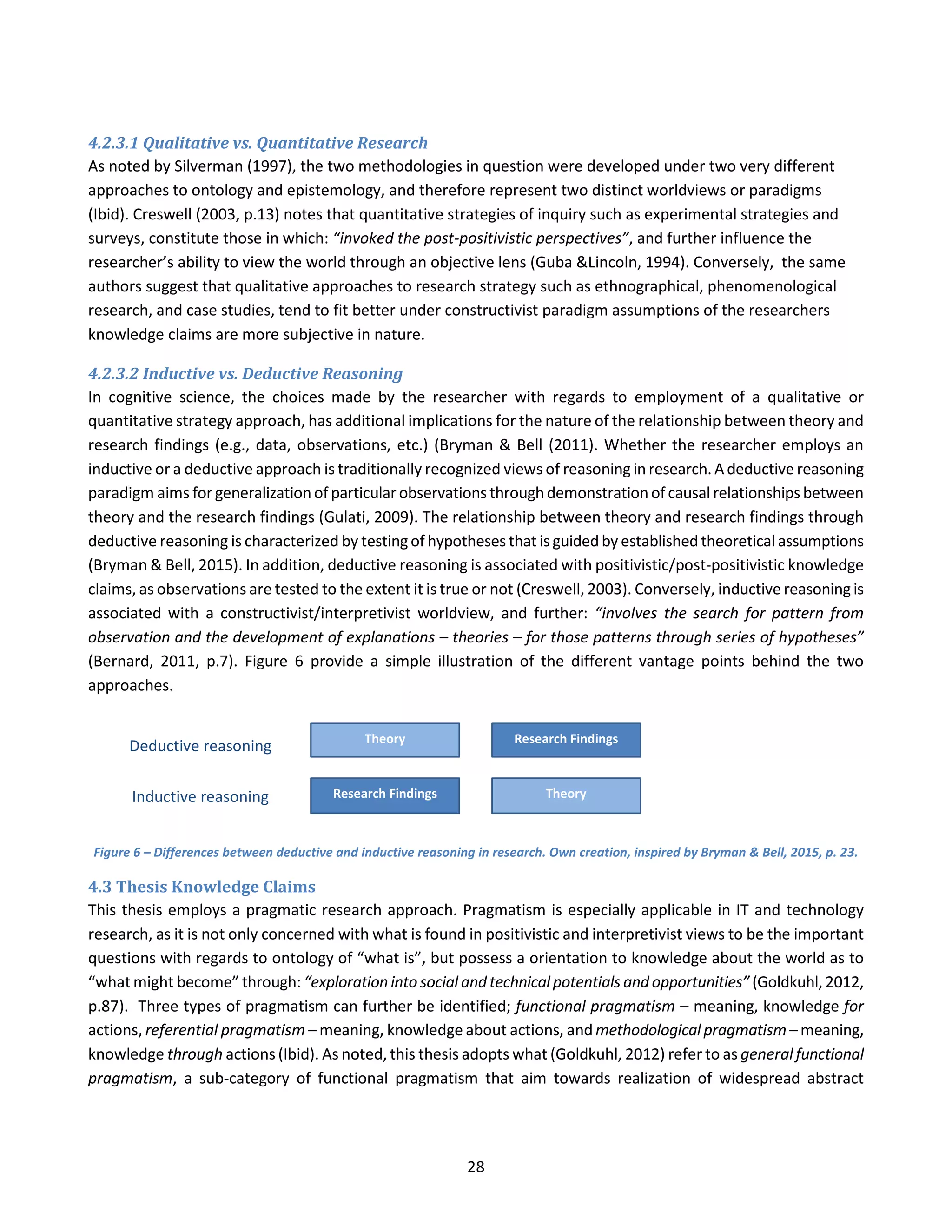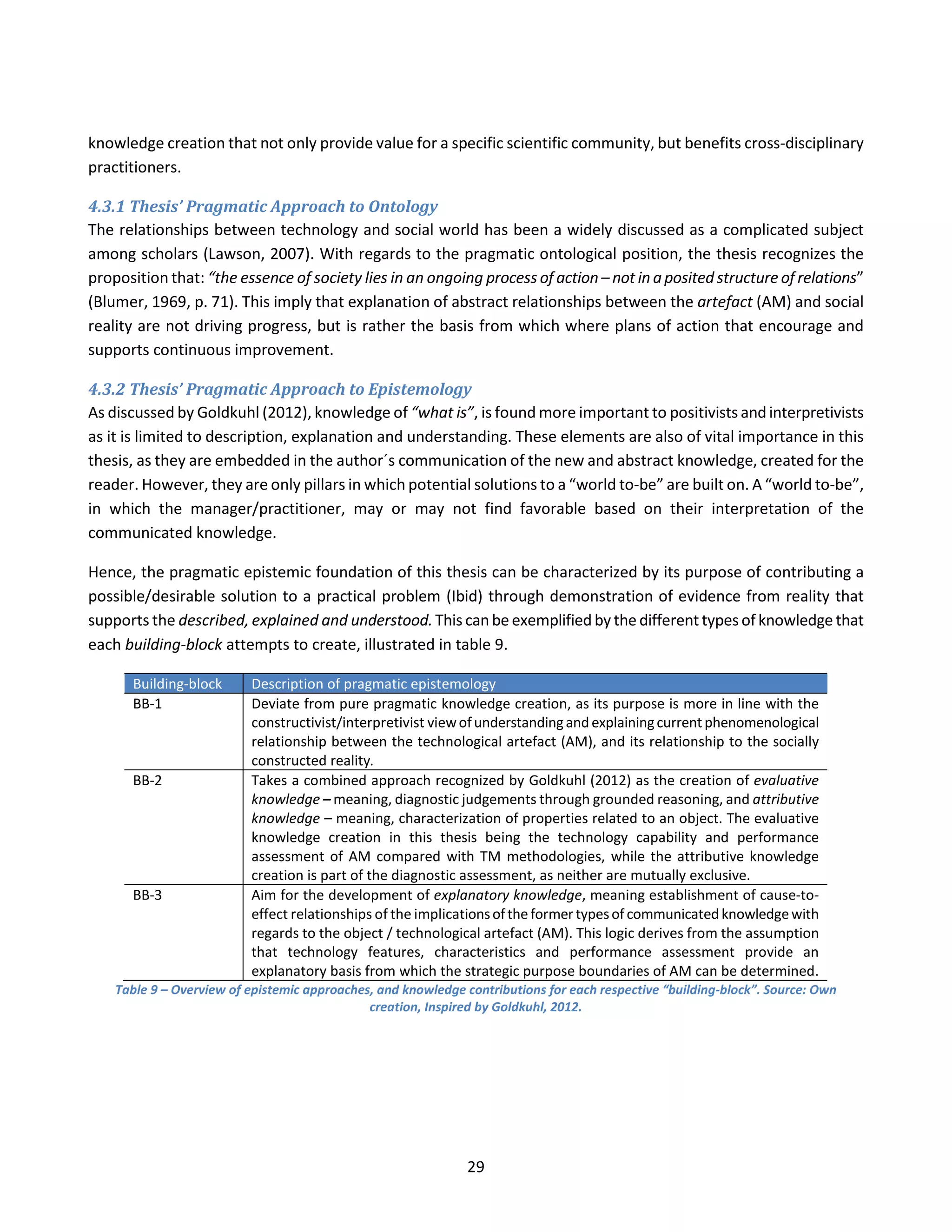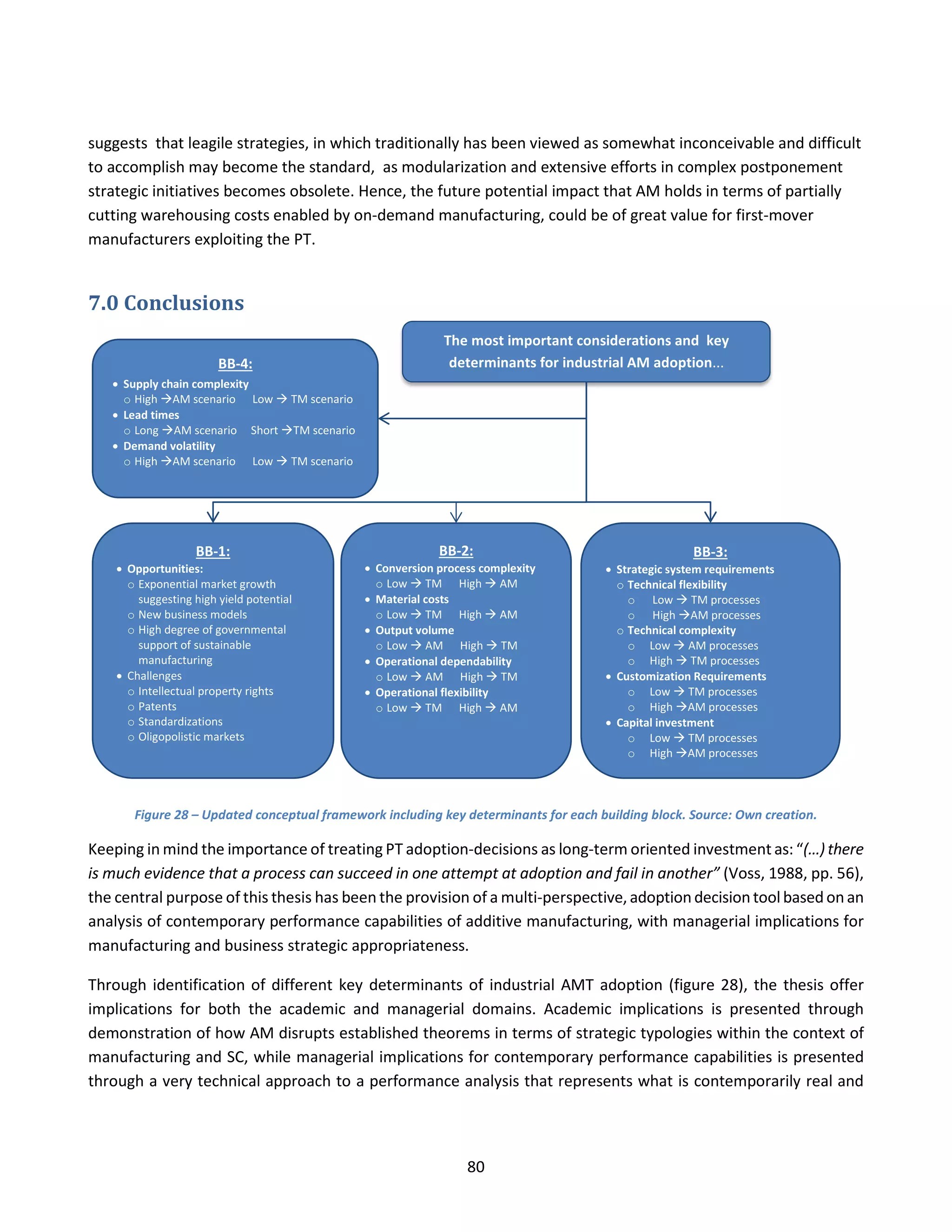This document provides an abstract for a thesis that examines the potential for industrial additive manufacturing adoption. The thesis uses a mixed methods approach to analyze contemporary additive manufacturing technology performance capabilities and identify suitable application areas. It suggests AM is viable for high flexibility manufacturing environments requiring low-medium production volumes of complex, customized parts. The thesis also proposes that AM viability is linked to technology maturity and could support more sustainable manufacturing in the future.




















































































![8.0 List of References
Aboulkhair, N. T., Everitt, N. M., Ashcroft, I., & Tuck, C. (2014). Reducing porosity in AlSi10Mg parts processed
by selective laser melting. Additive Manufacturing, 1-4, 77–86.
Ajoku, U., Hopkinson, N., & Caine, M. (2006). Experimental measurement and finite element modelling of the
compressive properties of laser sintered Nylon-12. Materials Science and Engineering: A, 428(1-2), 211–216.
Algren, C., & Kotzab, H., (2011). State of the art of supply chain performance measurement in Danish
industrial companies. Proceedings of the 23rd Annual NOFOMA Conference: Logistics and Supply Chain
Management in a High North perspective, 1–17.
Alpern, P., (2010). Beam me up, Scotty. Industry Week, 259(2), 46–47.
[Online] Available at: http://www.industryweek.com/product-development/beam-me-part-scotty.
[Accessed 28.07.2015]
AM Platform, (2014). Additive manufacturing: strategic research agenda.
[Online] Available at: http://www.rm-platform.com/linkdoc/AM%20SRA%20-%20February%202014.pdf
[Accessed: 10.02.2015]
Additive manufacturing research group (AMRG) (2015). About additive manufacturing: Powder bed fusion,
Loughborough University. [Online] Available at:
http://www.lboro.ac.uk/research/amrg/about/the7categoriesofadditivemanufacturing/powderbedfusion/
[Accessed: 28.05.2015]
Additive manufacturing research group (AMRG) (2015). About additive manufacturing: Material jetting,
Loughborough University. [Online] Available at:
http://www.lboro.ac.uk/research/amrg/about/the7categoriesofadditivemanufacturing/materialjetting/
[Accessed: 28.05.2015]
Additive manufacturing research group (AMRG) (2015). About additive manufacturing: Binder jetting,
Loughborough University. [Online] Available at:
http://www.lboro.ac.uk/research/amrg/about/the7categoriesofadditivemanufacturing/binderjetting/
[Accessed: 28.05.2015]
Angelo, L. D., & Stefano, P. D. (2011). A neural network-based build time estimator for layer manufactured
objects. The International Journal of Advanced Manufacturing, 57(1-4), 215–224.
Arndt, S., & Kierzkowski, H. (2001). Fragmentation: new production patterns the world economy. Oxford:
Oxford University Press, Press, 1–16.
Atzeni, E., Iuliano, L., Minetola, P., & Salmi, A. (2010). Redesign and cost estimation of rapid manufactured
plastic parts. Rapid Prototyping Journal, 16(5), 308–317.
85](https://image.slidesharecdn.com/30a0f6dc-eb13-4b86-ba06-d408e9dbc5ed-170222085154/75/Thesis-incl-appendices-85-2048.jpg)
![Atzeni, E., & Salmi, A., (2012), Economics of additive manufacturing for end-usable metal parts. The
International Journal of Advanced Manufacturing Technology, 62(9-12), 1147–1155.
Bain & Co. (2011). The great eight; trillion-dollar growth trends to 2020. [Online] Available at:
http://www.bain.com/Images/BAIN_BRIEF_8MacroTrends.pdf
[Accessed: 17.03.2015]
Ballou, R. H. (2007). The evolution and future of logistics and supply chain management. European Business
Review, 19(4), 332–348.
Barnatt, C., (2013), 3D Printing: The Next Industrial Revolution. Pdf preface chapter 1 only): CreateSpace
Independent Publishing Platform. [Online] Available at: http://explainingthefuture.com/3dp_book.html
[Accessed: 20.07.2015]
Basiliere, P. (2015). 3D-printing disrupts healthcare and manufacturing. [Online] Available at:
http://blogs.gartner.com/pete-basiliere/2015/12/02/gartner-predicts-2016-3d-printing-disrupts-healthcare-
and-manufacturing/
[Accessed: 04.07.2015]
Barnes, D. (2008). Operations Management: An International Perspective. Royal Holloway, University of
London: Cengage Learning (Pdf sample chapter 2 only). [Online] Available at:
http://cws.cengage.co.uk/barnes/students/sample_ch/ch2.pdf
[Accessed: 26.08.2015]
Baumers, M., Dickens, P., Tuck, C., & Hague, R. (2016). The cost of additive manufacturing: Machine
productivity, economies of scale and technology-push. Technological Forecasting and Social Change, 102,
193–201.
Berger, R. (2013), Additive Manufacturing: A Game Changer for the Manufacturing Industry? [Online]
Available at:
https://www.rolandberger.com/media/pdf/Roland_Berger_Additive_Manufacturing_20131129.pdf
[Accessed: 26.01.2016]
Berman, B. (2012). 3-D printing: The new industrial revolution. Business Horizons,55(2), 155–162.
Bianchi, M., & Åhlström, P. (2014). Additive Manufacturing; towards a new operations management
paradigm. Center for Innovation and Operations Management, Stockholm School of Economics. [Online]
Available at: https://www.pomsmeetings.org/confpapers/051/051-0376.pdf
[Accessed: 02.03.2016]
Bourell, D., Leu, M.C., Rosen, D.W., (2009), Roadmap for additive manufacturing: Identify the future of
freeform processing. Texas: The University of Texas at Austin Laboratory for Freeform Fabrication Advanced
Manufacturing Center. [Online] Available at: http://3d-printing-review.com/roadmap-for-additive-
manufacturing-identifying-the-future-of-freeform-processing/
[Accessed: 08.03.2016]
86](https://image.slidesharecdn.com/30a0f6dc-eb13-4b86-ba06-d408e9dbc5ed-170222085154/75/Thesis-incl-appendices-86-2048.jpg)
![Buchbinder, D., Schleifenbaum, H., Heidrich, S., Meiners, W.,Bültmann, J. (2011). High power selective laser
melting (HP SLM) of aluminum parts. Physics Procedia 2011;12 Part A:271.
Briner, R. B., Denyer, D., & Rousseau, D. M. (2009). Evidence-based management: Concept cleanup time?
Academy of Management Perspectives, 23(4), 19–32.
Bryman, A., & Bell, E. (2015). Business research methods, 4th
ed., New York, NY: Oxford university press.
Business Insider (2012). Now anyone can use 3D printing to make money. [Online] Available at:
http://www.businessinsider.com/shapeways-3d-printing-2012-12?IR=T
[Accessed: 28.07.2015]
Business Insider (2013). The Economist Who Invented The BRICs Just Invented A Whole New Group Of
Countries: The MINTs. . [Online] Available at: http://www.businessinsider.com/jim-oneill-presents-the-mint-
economies2013-11?IR=T
[Accessed: 05.04.2015]
Campbell, I., Combrinck, J., Beer, D., & Barnard, L. (2008). Stereolithography build time estimation based on
volumetric calculations. Rapid Prototyping Journal, 14(5), 271-279.
Carter, C. R., & Rogers, D. S. (2008). A framework of sustainable supply chain management: moving toward
new theory. International Journal of Physical Distribution & Logistics Management, 38(5), 360–387.
Chabaud, C. (2015), Fashion industry & 3D printing: Exclusive interview of Danit Peleg, Interlaced’s founder &
Electroloom’s team. [Online] Available at: http://www.sculpteo.com/blog/2015/08/25/danit-peleg-
interlaced-electroloom-fashion-industry/
[Accessed: 04.07.2015]
Cherryholmes, C. H. (1992). Notes on pragmatism and scientific realism. Educational Researcher, 21(6), 13-17.
[Online] Available at: https://www.depts.ttu.edu/education/our-
people/Faculty/additional_pages/duemer/epsy_5382_class_materials/Notes-on-pragmatism-and-scientific-
realism.pdf [Accessed: 14.12.2015]
Christensen, C.M. (1997). The innovator’s dilemma: when new technologies cause great firms to fail. Boston:
Harvard Business School; 1997.
Christopher, M., Peck, H., & Towill, D. (2006). A taxonomy for selecting global supply chain strategies, The
International Journal of Logistics Management, 17(2), 277-287.
Cohen, D., M. Sargeant, K. Somers. (2014). 3-D printing takes shape. McKinsey Quarterly. [Online] Available
at: http://www.mckinsey.com/insights/manufacturing/3-d_printing_takes_shape
[Accessed: 13.03.2016]
Conner, M., Manogharan, G.P. (2014). Making sense of 3-D printing: Creating a map of additive
manufacturing products and services. Additive manufacturing, 1-4, 64 – 76
87](https://image.slidesharecdn.com/30a0f6dc-eb13-4b86-ba06-d408e9dbc5ed-170222085154/75/Thesis-incl-appendices-87-2048.jpg)
![Cotteleer, M. (2014). 3D opportunity for production Additive manufacturing makes its (business) case.
Deloitte review issue 15, 2014. [Online] Available at:http://dupress.com/articles/additivemanufacturing-
business-case/[Accessed: 28.07.2015]
Cotteleer, M., Holdowsky, J., and Mahto M., (2014). 3D opportunity primer. [Online] Available at:
http://dupress.com/articles/the-3d-opportunity-primer-the-basics-of-additive-manufacturing/
[Accessed: 04.08.2015.]
Cowton, C. J. (1998). The use of secondary data in business ethics research. Journal of Business Ethics 17(4),
423-434.
Creswell, J.W. (2003). Research design; Qualitative, quantitative and mixed methods approaches. 2nd
ed.
London: Sage.
Crosby, P. B. (1979). Quality is Free: The Art of Making Quality Certain: McGraw-Hill.
Crotty, M. (1998). The foundations of social march: Meaning and perspective in the research process.
London: Sage.
Deloitte (2015). 3D printing is a revolution: Just not the revolution you think. [Online] Available at:
http://www2.deloitte.com/content/dam/Deloitte/global/Documents/Technology-Media-
Telecommunications/gx-tmt-pred15-3d-printing-revolution.pdf
[Accessed: 21.07.2015]
Deming, W. E. (1986). Out of the crisis. Cambridge, MA: Massachusetts Institute of Technology, Center for
Advanced Engineering Study.
DNVGL – strategic research & innovation (2014). Additive manufacturing: A materials perspective. [Online]
Available at: https://issuu.com/dnvgl/docs/dnv_gl_pospaper__7-2014_additive_ma
[Accessed: 22.07.2015]
Dubois, A., Gadde, L.E. (2002). Systematic combining: an abductive approach to case research. Journal of
business research, 55(7), 553-560
Dunning, J.H. (2001). The eclectic (OLI) paradigm of international production: Past, present and future,
International Journal of Economics of Business, 8(2), 173- 190.
US Environmental Protection Agency (2015). Clean power plan for existing power plants. [Online] Available
at: https://www.epa.gov/cleanpowerplan/clean-power-plan-existing-power-plants
[Accessed: 04.10.2015]
European Commission Report (2004). Manufacture: A vision for 2020. [Online] Available at:
http://www.manufuture.org/documents/manufuture_vision_en%5B1%5D.pdf
[Accessed: 04.05.2016]
European Commission Report (2014). Additive manufacturing in FP7 and Horizon 2020: Report from the EC
workshop on additive manufacturing, June 2014. . [Online] Available at: http://www.rm-
platform.com/linkdoc/EC%20AM%20Workshop%20Report%202014.pdf
88](https://image.slidesharecdn.com/30a0f6dc-eb13-4b86-ba06-d408e9dbc5ed-170222085154/75/Thesis-incl-appendices-88-2048.jpg)
![[Accessed: 05.11.2015]
Feenstra, R. C. (1998). Integration of trade and disintegration of production in the global economy. Journal of
Economic Perspectives, 12(4), 31-50.
Ferdows, K., & De Meyer, A. (1990). Lasting improvements in manufacturing performance: In search of a new
theory, Journal of Operations Management 9(2), 168 – 184.
Frankfort-Nachmias, C., & Nachmias, D. (1996). Research Methods in the Social Sciences, 5th
edition. New York:
Worth Publishers.
Frost & Sullivan (2014). Market Implications of 3D Printing - Technical Insights. [Online] Available at:
http://www.frost.com/prod/servlet/analyst-briefing-detail.pag?mode=open&sid=284515909.
[Accessed: 28.07.2015]
Gartner (2012). Emerging technologies hype cycle for 2012. [Online] Available at:
http://blogsimages.forbes.com/gartnergroup/files/2012/09/2012EmergingTechnologies-Graphic4.gif
[Accessed: 24.07.2015]
Gartner (2013). Emerging technologies hype cycle for 2013. [Online] Available at:
http://na2.www.gartner.com/imagesrv/newsroom/images/hype-cycle-pr.png;wada20fd4bd7891509
[Accessed: 24.07.2015]
Gartner (2014). Emerging technologies hype cycle for 2014. [Online] Available at:
http://na1.www.gartner.com/imagesrv/newsroom/images/HC_ET_2014.jpg;wadf79d1c8397a49a2
[Accessed: 24.07.2015]
Gartner (2015). Emerging technologies hype cycle for 2015. [Online] Available at:
http://na2.www.gartner.com/imagesrv/newsroom/images/emerging-tech-hc.png;wa0131df2b233dcd17
[Accessed: 24.07.2015]
GE Capital (2013). Industry research monitor: Additive manufacturing. [Online] Available at:
http://www.americas.gecapital.com/GECA_Document/Additive_Manufacturing_Fall_2013.pdf
[Accessed: 15.03.2016]
GE Reports (2014). World’s first plant to print jet engine nozzles in mass-production.
Available at: http://www.gereports.com/post/91763815095/worlds-first-plant-to-print-jet-engine-nozzles-in
[Accessed: 15.03.2016]
Gibson, I.,Rosen, D W., & Stucker, B. (2010). Additive Manufacturing Technologies, Rapid Prototyping to
Direct Digital Manufacturing. Springer Science & Business Media, 2009, pp. 484.
Giffi, C.A., Gangula, B. & Illinda, P. (2014). 3D opportunity for the automotive industry. Deloitte University
Press. [Online] Available at: http://dupress.com/articles/additive-manufacturing-3d-opportunity-in-
automotive/?id=us:2el:3dc:dup707:awa:dup
[Accessed 10.02.2016]
Goldkuhl, G. (2012). EDSS 2011, CCIS 286. Springer-Verlag Berlin Heidelberg 2012, 84–95.
89](https://image.slidesharecdn.com/30a0f6dc-eb13-4b86-ba06-d408e9dbc5ed-170222085154/75/Thesis-incl-appendices-89-2048.jpg)
![Goldsby, T. (2013). The macro-trends at work in our supply chains. [Online] Available at:
http://www.schenkeronline.dk/download/CBS-SCM13-3_Macrotrends-at-Work-in-Our-Supply-Chains.pdf
[Accessed: 10.02.2015]
Größler, A., & Grübner, A., (2006). An empirical model of the relationships between manufacturing
capabilities. International Journal of Operations and Production Management 26(5), 458 – 485.
Guba, E.G., and Lincoln, Y.S. (1994). Competing paradigms in qualitative research," in Handbook of
Qualitative Research, N.K. Denzin and Y.S. Lincoln (eds.), Sage, Thousand Oaks, 105–117.
Guisinger, S. (2001). From OLI to OLMA: incorporating higher levels of environmental and structural
complexity into the eclectic paradigm. International Journal of Economics of Business, 8(2), 257–272.
Gulati, P.M. (2009) Research Management: Fundamental and Applied Research, Global India Publications.
Guo, N. & Leu, M.C. (2013). Additive Manufacturing: Technology, applications and research needs. Frontiers
in Mechanical Engineering, 2013, 8(3), 215–243.
Hallgren, M., (2007). Manufacturing strategy, capabilities and performance, Linköping Studies in Science and
Technology, Dissertations, 1108.
Harris, H. (2001). Content analysis of secondary data: A study of courage in managerial decision making,
Journal of Business Ethics, 34(3/4), 191–208.
Hayes, R.H., & Pisano, G.P. (1994). Beyond world-class: the new manufacturing strategy. Harvard Business
Review Jan/Feb, 77–86.
Hayes, R.H., & Wheelwright, S.C., (1984). Restoring our competitive edge: Competing through manufacturing,
New York: Wiley.
Herderick, E. (2011). Additive manufacturing of Metals: A review. Material science and technology. [Online]
Available at:
http://www.asminternational.org/documents/10192/23826899/cp2011mstp1413.pdf/04f142d0-f1ca-44d4-
8a10-891992e5529a
[Accessed: 14.02.2016]
Hesse, M., and Rodrigue, J.P. (2006). Global production networks and the role of logistics and transportation,
Growth and Change, 37(4), 499–509
Hill, T.J. (1993). Manufacturing Strategy, the Strategic Management of the Manufacturing Function, 2nd ed.,
London: Macmillan.
Hopkinson, N., & Dickens, P. (2003). Analysis of rapid manufacturing—using layer manufacturing processes
for production. Proceedings of the Institution of Mechanical Engineers, Part C: Journal of Mechanical
Engineering Science, 31–39.
Huang, S.H., Liu, P., Mokasdar, A., and Hou, L. (2012). Additive manufacturing and its societal impacy: A
literature review. International Journal of Advanced Manufacturing Technology, 67, 1191–1203.
90](https://image.slidesharecdn.com/30a0f6dc-eb13-4b86-ba06-d408e9dbc5ed-170222085154/75/Thesis-incl-appendices-90-2048.jpg)
![Jones, J., Wimpenny, D., & Gibbons, G. (2015). Additive manufacturing under pressure. Rapid Prototyping
Journal, 21(1), 89 – 97.
Jordan, C., Casinelli, C., & Nehro, J. (2014). EOS-New Balance Uses EOS Industrial 3D-Printing Technology to
Additively Manufacture. [Online] Available at: http://additivemanufacturing.com/2014/12/05/eos-new-
balance-uses-eos-industrial-3d-printing-technology-to-additively-manufacture/.
[Accessed: 05.02.2016]
Juran, J.M. (1988). Juran on Planning for Quality. The Free Press.
Kakkuri-Knuuttila, M. L., Lukka, K. & Kuorikoski, J. (2008). Straddling between paradigms: A naturalistic
philosophical study on interpretive research in management accounting. Accounting, Organizations and
Society, 33 (2-3), 267–91
Kechagias, J., Maropoulos, S., & Karagiannis, S. (2004). Process build‐time estimator algorithm for laminated
object manufacturing. Rapid Prototyping Journal, 10(5), 297-304.
Kim, Y., & Lee, J. (1993). Manufacturing strategy and production systems: An integrated framework, Journal
of Operations Management, 11, 3–15
Kotha, S. & Orne, D. (1989). Generic manufacturing strategies: A conceptual synthesis. Strategic Management
Journal, 10(3), 211–231
Kojima, K., & Ryan, L. (2010). Transport Energy efficiency; Implementation of IEA Recommendations since
2009 and next steps. International Energy Agency. [Online] Available at:
https://www.iea.org/publications/freepublications/publication/transport_energy_efficiency.pdf
[Accessed: 20.04.2015]
Krar, S.F., & Gill, A. (2003). Exploring advanced manufacturing technologies. Industrial Press, New York.
Kruth, J., Leu, M., & Nakagawa, T. (1998). Progress in additive manufacturing and rapid prototyping. CIRP
Annals - Manufacturing Technology, 47(2), 525-540.
Lawson, C. (2007). An ontology of technology: artefacts, relations and functions. Virginia Tech, 11(1). [Online]
Available at: https://scholar.lib.vt.edu/ejournals/SPT/v12n1/lawson.html
[Accessed 25.02.2016]
Leong, K., Liu, A., & Chua, C. (2009), A practical approach on temperature variation in Selective Laser Melting
with a novel heat transfer model. Advanced Research in Virtual and Rapid Prototyping - Proceedings of
VR@P4, Oct. 2009, Leiria, Portugal Innovative Developments in Design and Manufacturing.
Lewandrowski, N. (2014), 3D Printing for Fashion: Additive Manufacturing and its Potential to Transform the
Ethics and Environmental Impact of the Garment Industry. [Online] Available at:
http://ft.parsons.edu/skin/wp-content/uploads/2014/05/3Dprintingforfashion-final.pdf
[Accessed 04.07.2015]
91](https://image.slidesharecdn.com/30a0f6dc-eb13-4b86-ba06-d408e9dbc5ed-170222085154/75/Thesis-incl-appendices-91-2048.jpg)
![Lindemann C., U. Jahnke, M. Moi, and R. Koch (2012). Analyzing Product Lifecycle Costs for a Better
Understanding of Cost Drivers in Additive Manufacturing. Proceedings of the 2012 Solid Freeform Fabrication
Symposium, University of Texas: Austin.
Lindemann, C., Reiher, T., Jahnke, U., & Koch, R. (2015). Towards a sustainable and economic selection of part
candidates for additive manufacturing. Rapid Prototyping Journal, 21(2), 216–227.
Maheshwaraa, U., Bourell, D., Seepersad, C.C., (2007) Design and freeform fabrication of deployable
structures with lattice skins, Rapid Prototyping Journal, 13(4), 213–225.
Mani, M., Lane, B., Donmez, A., Feng, S., Moylan, S., & Fesperman, R. (2015). Measurement Science Needs for
Real-time Control of Additive Manufacturing Powder Bed Fusion Processes. National Institute of Science and
Technology. [Online] Available at: http://nvlpubs.nist.gov/nistpubs/ir/2015/NIST.IR.8036.pdf
[Accessed 21.07.2015]
Manners-Bell, J., & Lyon, K. (2012). The implications of 3-D Printing for the global logistics industry, Transport
Intelligence, 1–6. [Online] Available at: http://johnmannersbell.com/wp-
content/uploads/2013/11/The_impact_of_3D_Printing_on_Global_Supply_Chains.pdf.
[Accessed: 20.07.2015]
Manuj, I., & Mentzer, J. (2008). Global Supply Chain Risk Management. Journal of Business Logistics, 29(1),
133-155.
Marchese, K., Crane, J., and Haley, C.,(2015) 3D opportunity for the supply chain: Additive manufacturing
delivers. DUpress. [Online] Available at: http://dupress.com/articles/additive-manufacturing-3d-printing-
supply-chain-transformation/
[Accessed 12.10.2015]
MarketLine (2013). 3D Printing the technological Marvel with the Potential to Revolutionize Manufacturing.
[Online] Available at:
http://marketline.com/Product/3d_printing_the_technological_marvel_with_the_potential_to_revolutionize
_manufacturing?productid=ML00013-021
[Accessed: 28.07.2015]
Mashhadi, A. R., Esmaeilian, B., and Behdad, S., (2015). Impact of additive manufacturing adoption on future
of supply chains. Proceedings of the ASME 2015 International Manufacturing Science and Engineering
Conference, MSEC2015 June 8-12, Charlotte: North Carolina.
McKinsey (2013). Disruptive technologies: Advances that will transform life, business, and the global
economy. The McKinsey Global Institute. [Online] Available at:
http://www.mckinsey.com/insights/business_technology/disruptive_technologies
[Accessed 05.07.2015]
McKinsey (2013). Mapping Chinas middle class. McKinsey quarterly [Online] Available
at:http://www.mckinsey.com/insights/consumer_and_retail/mapping_chinas_middle_class
[Accessed: 05.04.2015]
92](https://image.slidesharecdn.com/30a0f6dc-eb13-4b86-ba06-d408e9dbc5ed-170222085154/75/Thesis-incl-appendices-92-2048.jpg)
![Mellor, S. (2014). An implementation framework for additive manufacturing. College of Engineering,
Mathematics and Physical Science, Exeter University: Exeter.
Meyers, P.W., Sivakumar, K., Nakata, C., (1999). Implementation of industrial process innovations: Factors,
effects, and marketing implications, Journal of Product Innovation Management, 16(3), 295–311.
Mikell P. Groover & Society of Manufacturing Engineers (2007). Fundamentals of modern manufacturing
materials, processes, and systems. 3rd ed. Hoboken, N.J: John Wiley & Sons.
[Online] Available at:
http://50.30.47.15/ebook/IPE/Fundamentals_of_Modern_Manufacturing_4th_Edition_By_Mikell_P.Groover.
pdf [Accessed: 07.06.2015]
Miller, J.G. and Roth, A.V. (1994), “A taxonomy of manufacturing strategies”, Management Science, 40(3),
285-304.
Minshall, T., (2015), Additive manufacturing: Dr Tim Minshall, Institute for Manufacturing, University of
Cambridge. https://vimeo.com/149642675
Moore, G., (2007), To succeed in the long term, focus on the middle term, Harvard Business Review, July-
August, 2007.
Morgan Stanley (2014 ) Capital Goods: 3D Printing - Don't Believe (All) The Hype. [Online] Avalable at:
http://www.wisburg.com/wp-content/uploads/2014/09/%EF%BC%8876-pages-2014%EF%BC%89MORGAN-
STANLEY-BLUE-PAPER-CAPITAL-GOODS%EF%BC%9A-3D-PRINTING-DONT-BELIEVE-ALL-THE-HYPE1.pdf.
[Accessed: 09.09.2015]
Mueller, B., & Kochan, D. (1999). Laminated object manufacturing for rapid tooling and patternmaking in
foundry industry. Computers in Industry, 39, (1), 47–53.
Orlikowski, W.J. and Baroudi, J.J (1991). Studying Information Technology in Organizations: Research
Approaches and Assumptions, Information Systems Research, 2(1), 1–8.
Paton, S., Clegg, B., Hsuan, J., & Pilkington, A. (2011). Operation Management. (1. ed.) Sydney: McGraw-Hill
Companies.
Petrovic, V., Vicente Haro Gonzalez, J., Jordá Ferrando, O., Delgado Gordillo, J., Ramon Blasco Puchades, J., &
Portoles Grinan, L. (2011). Additive layered manufacturing: Sectors of industrial application shown through
case studies. International Journal of Production Research, 49(4), 1061–1079.
Pham, D.T., & Gault, R.S., (1998). A comparison of rapid prototyping technologies. International Journal of
Machine Tools and Manufacture, 38(10-11), 1257–1287.
Pine, B.J., Victor, B. and Boynton, A.C., (1993), “Making mass customization work”, Harvard Business Review,
September-October, pp. 108-19.
Platts, K.W., & Gregory, M.J., (1992). A manufacturing audit approach to strategy formulation, Manufacturing
Strategy: Process and Content, in Voss, C.A., Chapman & Hill, London.
Porter, M.E. (1980) Competitive Strategy, New York: Free Press.
93](https://image.slidesharecdn.com/30a0f6dc-eb13-4b86-ba06-d408e9dbc5ed-170222085154/75/Thesis-incl-appendices-93-2048.jpg)
![Porter, M.E. (1985) Competitive Advantage, New York: Free Press.
Price, T.R. (2012). A brief history of 3D printing. [Online] Available at:
http://individual.troweprice.com/staticFiles/Retail/Shared/PDFs/3D_Printing_Infographic_FINAL.pdf.
[Accessed: 17.04.2015]
Reeves P., (2008). How the socioeconomic benefits of rapid manufacturing can offset technological
limitations. RAPID 2008 conference and exposition. Lake Buena Vista, FL: 1-12.
Rodrigue, J. (2012). The Geography of Global Supply Chains: Evidence from Third-Party Logistics. Journal of
Supply Chain Management, 48(3), 15–23.
Royal Academy of Engineering (2013). London. [Online] Available at:
http://www.raeng.org.uk/publications/reports/additive-manufacturing
[Accessed: 10.03.2016]
Roylance, D. (2008) Mechanical Properties of Materials. Publisher: MIT. [Online] Available at:
http://web.mit.edu/course/3/3.225/book.pdf
[Accessed: 07.03.2016]
Ruffo, M., and Hague, R. (2007). Cost estimation for rapid manufacturing – simultaneous production of mixed
components using laser sintering. Proceedings of IMech E Part B: Journal of Engineering Manufacture,
221(11), 1585-1591.
Ruffo, M., Tuck, C., & Hague, R. (2006). Empirical laser sintering time estimator for Duraform
PA. International Journal of Production Research, 44(23), 5131–5146.
Saunders, M., Lewis, P. & Thornhill, A. (2009). Research Methods for Business Students, 5th ed., Harlow,
Essex: Pearson Education.
Senthilkumaran, K., Pandey, P., Rao, P.V.M. (2009). New model for shrinkage compensation in selective laser
sintering. Virtual and physical prototyping, 4(2), 49–62.
Sherman, L. M. (2009). Additive manufacturing: New capabilities for rapid prototypes and production parts.
Plastics Technology, 55(3), 35–45.
Silverman, D. (1997). Qualitative Research: Theory, Method and Practice. London: Sage
Singh, S., Sachdeva, A., and Vishal, S., (2012). Investigation of Dimensional Accuracy/Mechanical Properties of
Part Produced by Selective Laser Sintering.InternationalJournalofAppliedScienceandEngineering,10(1),59–68.
Skinner, W., (1969). Manufacturing – the missing link in corporate strategy, Harvard Business Review May/Jun,
136–145.
Slack, N., Chambers, S., and Johnston, R. (2010). Operations Management, 6th
Ed., Essex; Pearson Education
Limited. [Online] available at:
http://50.30.47.15/ebook/IPE/Operations_Management_6th_ed_N.Slack_et_al_(Pearson,2010)_BBS.pdf
[Accessed 16.04.2016]
Slack, N., & Lewis, M. (2011). Operations strategy (3rd ed.). Harlow, Essex: Pearson/Prentice Hall.
94](https://image.slidesharecdn.com/30a0f6dc-eb13-4b86-ba06-d408e9dbc5ed-170222085154/75/Thesis-incl-appendices-94-2048.jpg)
![Spierings, A.B., Wegner, K., Levy, G. (2012) Designing Material Properties Locally with Additive Manufacturing
technology SLM. Proceedings of the solid freeform fabrication symposium, Austin, TX, USA.
Accessed: 13.04.16
Sreenivasan, R., and Bourell, D. (2009). Sustainability Study in Selective Laser Sintering – An Energy Perspective.
Proceedings of the 20th AnnualInternationalSolidFreeform FabricationSymposium,SFF2009,UniversityofTexas
at Austin. 257–265
Strauss, A., & Corbin, J. (1990). Basics of QualitativeResearch.Groundedtheoryproceduresandtechniques,Sage
Publications, Newbury Park (1990).
Stan, D., Tulcan, A., Liliana, T., Iclanzan, T., (2008), Influencing factors on the dimensional accuracy of the plastic
parts. Materiale plastice, 45(1), 119–124.
Steinhilper, R., Westermann, H., Butzer, S., Haumann, M., Seifert, S., (2012). Komplexität messbar machen.
ZWF Journal of Economic Factory Operation, 107, 361.
Swamidass, P.M. and Newell, W.T. (1987). Manufacturing strategy, environmental uncertainty and
performance: A path model, Management Science, 33(4), 509 – 524.
Swink, M., & Hegarty, W.H. (1998). Core manufacturing capabilities and their links to product differentiation,
International Journal of Operations and Production Management 18(4), 374–396.
Sørensen, B. (2004). A brief note on literature studies – part II, Dept. of Operations Management,
Copenhagen Business School. [Online] Available at: http://openarchive.cbs.dk/cbsweb/handle/10398/6295
[Accessed: 15.12.2015]
Tan, K.C., Kannan, V.R., and Narasimhan, R. (2006). The impact of operations capability on firm performance.
International Journal of Production Research, 45(21), 5135–5156.
Telenko, C., & Seepersad, C.C. (2012). A Comparison of the Energy Efficiency of Selective Laser Sintering and
Injection Molding of Nylon Parts. Rapid prototyping journal 18(6), 472–481.
The Economist (2012). Solid print: Making things with a 3D printer changes the rules of manufacturing.
[Online] Available at: http://www.economist.com/node/21552892
[Accessed: 12.07.2015]
Thomas, D., & Gilbert, S. (2014). Costs and Cost Effectiveness of Additive Manufacturing. National Institute of
Standards and Technology. [Online] Available at:
http://nvlpubs.nist.gov/nistpubs/SpecialPublications/NIST.SP.1176.pdf
[Accessed: 04.06.2015]
Tuck, C., Hague, R., & Burns, N. (2007). Rapid manufacturing: Impact on supply chain methodologies and
practice. International Journal of Services and Operations Management, 3(1), 1–22.
United States Department of Commerce (2014). Obama administration announces new public-private
partnership to support manufacturing innovation, encourage investment in America. [Online] Available at:
95](https://image.slidesharecdn.com/30a0f6dc-eb13-4b86-ba06-d408e9dbc5ed-170222085154/75/Thesis-incl-appendices-95-2048.jpg)
![http://2010-2014.commerce.gov/news/press-releases/2012/08/16/obama-administration-announces-new-
public-private-partnership-support
[Accessed: 20.06.2015]
Voss, C, A., (1986). Implementing manufacturing technology: A manufacturing strategy approach,
International Journal of Operations & Production Management. 6(4), 17 – 26.
Voss, C. A. (1988). Success and failure in advanced manufacturing technology. International Journal of
Technology Management, 3(3) 285 – 297.
Voss, C.A., (2005). Alternative paradigms for manufacturing strategy. International Journal of Operations &
Production Management, 25(12), 1211–1222.
Wagner, S. (2010). UK engineers speed 3D printing technology. The Engineer. [Online] Available
at:https://www.theengineer.co.uk/issues/14-june-2010/engineers-build-3d-printer-for-making-plastic-parts/
[Accessed: 5.3.2016]
Walter, M., Holmstrom, J., and Yrjola, H., (2004). Rapid manufacturing and its impact on supply chain
management. LRN Annual Conference, September 9–10, Dublin, Ireland
Weller, C., Kleer, R., and Piller. F.T., (2015). Economic implications of 3D printing: Market structure models in
light of additive manufacturing revisited, International Journal of production economics, 164, 43–56.
Wilkes, K., Hagerdorn,Y.C., Meiners, W., Wissenbach, K., (2013). Additive manufacturing of ZrO2-Al2O3
ceramic components by selective laser melting, Rapid Prototyping Journal, 19(1), 51–57.
Wohlers Associates, (2013). Wohlers Report: 3D Printing and Additive Manufacturing State of the Industry,
Annual Worldwide Progress Report. Fort Collins.
[Accessed: 21.07.2015]
Wohlers Associates, (2014). Wohlers Report: 3D Printing and Additive Manufacturing State of the Industry,
Annual Worldwide Progress Report. Fort Collins.
[Accessed: 21.07.2015]
Wohlers Associates, (2015). Wohlers Report: 3D Printing and Additive Manufacturing State of the Industry,
Annual Worldwide Progress Report. Fort Collins. (executive summary only).
[Accessed: 21.07.2015]
Xu, W., Brandt, M., Sun, S., Elambasseril, J., Liu, Q., Latham, K., and Qian, M. (2015). Additive manufacturing
of strong and ductile Ti–6Al–4V by selective laser melting via in situ martensite decomposition. Acta
Materialia, 85(15), 74 – 84.
96](https://image.slidesharecdn.com/30a0f6dc-eb13-4b86-ba06-d408e9dbc5ed-170222085154/75/Thesis-incl-appendices-96-2048.jpg)
![Other: Data & Terminology
ISO/ASTM 52901 Standards for additive manufacturing technologies. Available at:
https://www.iso.org/obp/ui/#search
[Accessed: 07.06.2015]
Material properties & average values of injection molded specimens using nylon 12 PA. Available at:
http://www.efunda.com/materials/polymers/properties/polymer_datasheet.cfm?MajorID=PA&MinorID
=81 [Accessed: 14.10.2015]
Properties & average values of injection molded specimens Nylon 12 PA. Available at:
http://web.rtpcompany.com/info/data/0200F/RTP200F.htm
[Accessed: 14.10.2015]
Mechancial properties for plastic materials. Available at:
http://www.matweb.com/reference/tensilestrength.aspx
[Accessed: 14.10.2015]
“DIN 16901 Engineering Plastic Tolerance table” Available at:
http://www.engmatl.com/home/view.download/20/155
[Accessed: 14.10.2015]
Technical description of Injection molding processes. Available at:
http://www.custompartnet.com/wu/InjectionMolding
[Accessed: 10.04.2016]
Technical description of High-pressure die-casting processes. Available at:
http://www.custompartnet.com/wu/die-casting
[Accessed: 10.04.2016]
97](https://image.slidesharecdn.com/30a0f6dc-eb13-4b86-ba06-d408e9dbc5ed-170222085154/75/Thesis-incl-appendices-97-2048.jpg)






![Powder Bed Fusion
The SLS powder bed fusion process is similar to
that of SLA as it involves the sinteringof powder
materials using a laser (Senthilkumaran et al.,
2009) The laser beam thereby selectively sinter
either powdered materials such as nylon,
titanium, aluminum and polystyrene, and/or
metal composite materials into successive
cross-sections of a three-dimensional part
(custompartnet, 2015). The SLS process uses a
laser that sinters selectively a thin layer of
powder spread over a platform. A computer
directs a laser scanningmirrors over the powder
layer,
sintering and attaching a new layer of the part [4]. Eachtime a layer is finished, the platform is lowered and
a new layer of powder is spread over the previously built layer. This process is repeated sequentially until
the part is completed and the sintered product is thenseparated from un-sinteredpowder after the cooling
down stage.
Binder Jetting
The process involves the combination of two
materials; a powder based material and a
binder. Materials include metals such as
stainless steel, polymers such as ABS plastic,
and ceramics such as glass. This particular type
of AM process technology is usually referredto
as 3DP, a term in which is it trademarked
under. Advantages include a wide range of
applicable materials such as metal, polymers
and ceramics and high process speed. In
addition, this two-material method provides
many binder-powder combinations and allow
for a wide range of
mechanical properties (LoughboroughUniversity AMRG, 2015). Existingdisadvantagessuchas manual post-
processing increase the time frame of the process and makes it unviable for industrial application.
104](https://image.slidesharecdn.com/30a0f6dc-eb13-4b86-ba06-d408e9dbc5ed-170222085154/75/Thesis-incl-appendices-104-2048.jpg)














